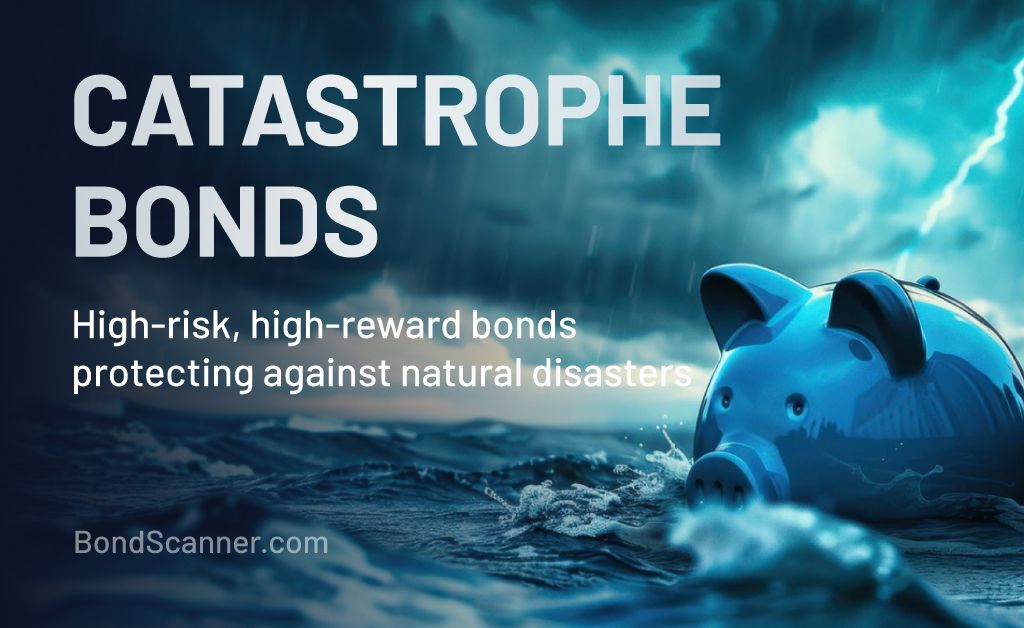Catastrophe Bonds: A Modern Financial Shield Against Disasters
11 November 2025

What Are Catastrophe Bonds?
Natural disasters such as floods, earthquakes, and cyclones have a significant financial impact, often straining government funds and insurance companies. To mitigate these risks, financial markets have developed an innovative instrument — catastrophe bonds (Cat Bonds). These bonds help transfer the financial burden of catastrophic events from insurers to capital market investors.
This article explores how catastrophe bonds work, their structure, role in India, and risks involved, providing an educational overview of this evolving segment of the bond market.
Catastrophe bonds are high-yield debt instruments designed to raise funds for insurers or reinsurers in the event of a major disaster. They are typically issued by a special purpose vehicle (SPV) that collects funds from investors.
If no catastrophic event occurs during the bond’s tenure, investors receive regular interest payments and their principal amount back at maturity. However, if a defined disaster (such as an earthquake or hurricane) occurs, part or all of the bond’s principal is used to cover the losses faced by the insurer or government agency.
In essence, catastrophe bonds allow insurers to transfer risk to investors, thereby stabilizing financial systems in times of crisis.
How Do Catastrophe Bonds Work?
Cat bonds are structured through a Special Purpose Vehicle (SPV) that acts as a buffer between investors and the insurer.
Here’s how the process typically works:
Issuance: The insurer (called the sponsor) identifies a risk — for instance, losses due to a cyclone.
SPV Creation: An SPV is set up to issue the catastrophe bond to investors.
Investor Funding: Investors purchase these bonds, and their funds are held in trust by the SPV.
Trigger Event: If a predefined disaster occurs, the SPV releases part or all of the funds to the insurer.
No Event: If no trigger occurs during the term, investors earn interest and get back their principal at maturity.
This structure ensures transparency, legal separation of assets, and clear risk transfer between the parties involved.
Catastrophe Bonds in India
India faces frequent natural disasters — floods, cyclones, droughts, and earthquakes — which makes catastrophe risk financing increasingly relevant.
While catastrophe bonds are still in a nascent stage in India, discussions around developing a domestic catastrophe bond market have gained attention.
The Insurance Regulatory and Development Authority of India (IRDAI) and Ministry of Finance have explored models used in global markets, such as those by the World Bank, to enhance disaster risk management.
For example, sovereign catastrophe bonds could help India finance relief and reconstruction efforts after large-scale disasters without putting pressure on fiscal budgets.
If implemented effectively, catastrophe bonds could play a key role in strengthening India’s financial resilience against natural calamities.
Examples of Catastrophe Bonds Globally
While India is still exploring this market, several global examples highlight the effectiveness of cat bonds:
World Bank Cat Bonds: Issued to support disaster relief in countries vulnerable to earthquakes and hurricanes.
Mexico’s FONDEN Program: The Mexican government used catastrophe bonds to fund post-disaster recovery efforts.
Japan Earthquake Cat Bonds: Issued to protect against large-scale earthquake losses.
These examples show how catastrophe bonds blend finance with social and environmental responsibility, helping communities recover faster after disasters.
Benefits of Catastrophe Bonds
Catastrophe bonds offer advantages to multiple stakeholders:
For Insurers and Governments: They provide an alternative risk transfer mechanism, reducing financial strain after major disasters.
For Investors: They offer portfolio diversification since returns are generally uncorrelated with broader market movements.
For the Economy: They help maintain stability by ensuring rapid financial assistance in post-disaster scenarios.
However, investors must be aware of the underlying risks, which are often tied to unpredictable natural events.
Risks Associated with Catastrophe Bonds
Like all financial instruments, catastrophe bonds carry risks:
Event Risk: The biggest risk is the occurrence of a qualifying catastrophe leading to loss of principal.
Model Risk: Estimation models for natural disasters can be uncertain, affecting pricing and outcomes.
Liquidity Risk: The market for cat bonds is relatively less liquid compared to conventional bonds.
Complexity: Understanding the trigger mechanisms and payout structures requires specialized knowledge.
Investors should thoroughly assess these factors before considering exposure to catastrophe-linked securities.
Listed vs Unlisted Catastrophe Bonds
While most catastrophe bonds are listed on international exchanges such as the Bermuda Stock Exchange, the Indian market currently lacks a structured listing framework for such instruments.
As India’s financial markets evolve and regulations mature, the potential for listed catastrophe bonds may open new avenues for institutional investors seeking socially impactful fixed-income opportunities.
Taxation of Catastrophe Bonds in India
At present, India does not have a defined taxation policy for catastrophe bonds since they are not yet widely issued.
Globally, interest income from cat bonds is typically treated as regular bond income, and capital gains tax may apply depending on jurisdiction.
Once the Indian framework develops, taxation norms will likely align with general debt securities regulations.
Conclusion
Catastrophe bonds represent an innovative way to bridge the gap between financial markets and natural disaster management.
As India explores ways to enhance disaster resilience, introducing cat bonds could provide a sustainable financing mechanism for post-disaster recovery efforts.
While this market is still emerging in India, lessons from global examples show that catastrophe bonds can balance profitability with purpose, making them a valuable component in the evolving landscape of sustainable finance.
FAQs
1. What are catastrophe bonds used for?
Catastrophe bonds are used to transfer the financial risk of natural disasters from insurers or governments to investors, providing liquidity for post-disaster recovery.
2. Are catastrophe bonds available in India?
Currently, catastrophe bonds are not widely available in India, but regulators are studying global models to potentially introduce them in the future.
3. How do investors earn returns from catastrophe bonds?
Investors earn periodic interest payments as long as no predefined catastrophic event occurs. If such an event happens, the principal may be used to cover losses.
4. Who issues catastrophe bonds?
Catastrophe bonds are typically issued by insurance companies, reinsurance firms, or government entities through Special Purpose Vehicles (SPVs).
5. What are the main risks of catastrophe bonds?
The primary risks include loss of principal in case of a qualifying event, model risk, and limited market liquidity.
Disclaimer
This blog is intended solely for educational and informational purposes. The bonds and securities mentioned herein are illustrative examples and should not be construed as investment advice or personal recommendations. BondScanner, as a SEBI-registered Online Bond Platform Provider (OBPP), does not provide personalized investment advice through this content.
Readers are advised to independently evaluate investment options and seek professional guidance before making financial decisions. Investments in bonds and other securities are subject to market risks, including the possible loss of principal. Please read all offer documents and risk disclosures carefully before investing.
Recent Blogs

Debt Securitization in India: Meaning & Structure
An educational guide explaining debt securitization, how securitized debt instruments work, and their role in India’s debt market.
26 Dec 2025

Debt Securities Explained: Types, Features & Trading
An educational guide explaining what debt securities are, their features, types in India, and how they differ from equity securities.
26 Dec 2025

What Is a Debt Trap? Meaning & Causes Explained
An educational guide explaining what a debt trap is, how it forms, and how investors should understand debt-related risks.
26 Dec 2025